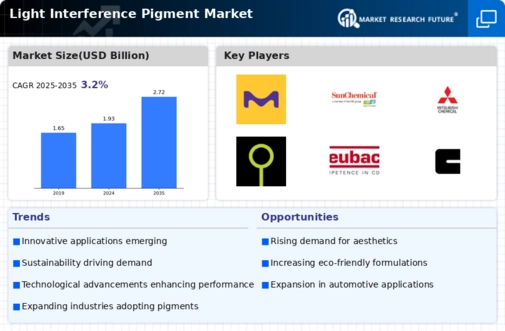Market Growth Projections
The Global Light Interference Pigment Market Industry is projected to experience robust growth over the next decade. With a market value of 1.93 USD Billion in 2024, it is anticipated to reach 2.72 USD Billion by 2035. This growth trajectory indicates a compound annual growth rate of 3.18% from 2025 to 2035. The increasing demand across various sectors, including automotive, cosmetics, and packaging, underpins this positive outlook. As industries continue to explore the benefits of light interference pigments, the market is poised for sustained expansion.
Growth in Cosmetic Applications
The Global Light Interference Pigment Market Industry is witnessing substantial growth driven by the cosmetics sector. As consumers increasingly favor products that offer unique visual effects, manufacturers are incorporating light interference pigments into makeup formulations. These pigments provide a shimmering, multi-dimensional appearance that appeals to a broad demographic. The rising trend of cosmetic personalization further fuels this demand, as brands aim to differentiate their products. This sector's expansion is anticipated to play a pivotal role in the market, contributing to the projected growth to 2.72 USD Billion by 2035.
Rising Demand in Automotive Sector
The Global Light Interference Pigment Market Industry experiences a notable surge in demand from the automotive sector. As manufacturers increasingly seek innovative ways to enhance vehicle aesthetics and durability, light interference pigments are becoming essential for achieving vibrant colors and unique finishes. The automotive industry is projected to contribute significantly to the market, with a focus on environmentally friendly formulations. This trend aligns with the overall market growth, which is expected to reach 1.93 USD Billion in 2024, reflecting a growing preference for high-performance coatings that utilize these pigments.
Expanding Applications in Packaging
The Global Light Interference Pigment Market Industry is experiencing expansion due to the increasing applications of these pigments in packaging. As brands strive to create visually appealing packaging that stands out on shelves, light interference pigments offer unique aesthetic qualities that enhance product visibility. This trend is particularly relevant in the food and beverage sector, where packaging plays a critical role in consumer decision-making. The integration of these pigments into packaging materials is likely to contribute to the overall market growth, as companies recognize the value of innovative design in attracting consumers.
Increasing Focus on Sustainable Products
The Global Light Interference Pigment Market Industry is increasingly shaped by the growing emphasis on sustainability. Consumers and manufacturers alike are prioritizing eco-friendly products, leading to a shift towards pigments derived from natural sources or produced through sustainable methods. This trend is particularly evident in the coatings and cosmetics industries, where brands are reformulating products to align with environmental standards. The demand for sustainable light interference pigments is expected to rise, as companies seek to enhance their market positioning by adopting greener practices. This shift may further drive the market's growth in the coming years.
Technological Advancements in Pigment Production
Technological advancements in the production of light interference pigments significantly influence the Global Light Interference Pigment Market Industry. Innovations in manufacturing processes enhance the quality and efficiency of pigment production, leading to improved performance characteristics. These advancements allow for the development of pigments that exhibit superior color stability and environmental resistance. As a result, manufacturers can meet the increasing demands of various industries, including automotive and cosmetics. The ongoing evolution in production technology is likely to support the market's growth trajectory, contributing to a compound annual growth rate of 3.18% from 2025 to 2035.
















